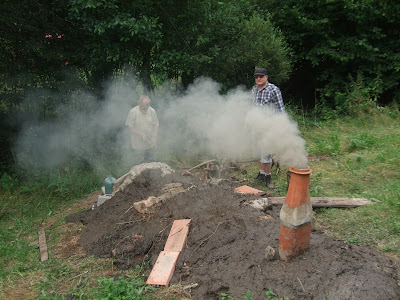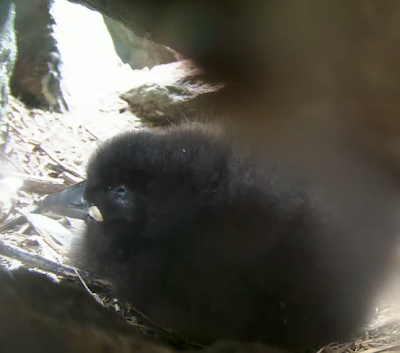Matthew and family arrived safely on Sunday after lunch and old favourites were quickly discovered.
New projects were started:
But not necessarily finished:
On Wednesday we all went to the animal park at Colombier. The weather was very hot but it is an attractive place and we had a good day out.
There were bears, lions, wolves, monkeys, deer and owls to be seen.
We were able to explore parts of the chateau:
After watching someone else do it the girls decided to fill their caps with water to cool off.
There was no restaurant but a shop serving drinks, ices and souvenirs and plenty of excellent pic-nicking places. Several games were available for people to play. Here is Tess playing chess with herself.
There was also a formal botanic garden but we were all so hot that we gave that a miss, sadly.
Last year Jim and Matthew started to build a Japanese Anagama kiln in the abandoned pumpkin field but after two days of heavy rain the project had to be postponed until this year. After several days of building it has been completed and on Thursday was lit for the first time. There were some pots made last year put in the kiln to test it's effectiveness.
 |
| Bo on the Walnut tree swing |
 |
| Tess with her pony |
But not necessarily finished:
 |
| 'Ray Mears' survival shelter needing more leaves |
On Wednesday we all went to the animal park at Colombier. The weather was very hot but it is an attractive place and we had a good day out.
There were bears, lions, wolves, monkeys, deer and owls to be seen.
We were able to explore parts of the chateau:
After watching someone else do it the girls decided to fill their caps with water to cool off.
There was no restaurant but a shop serving drinks, ices and souvenirs and plenty of excellent pic-nicking places. Several games were available for people to play. Here is Tess playing chess with herself.
There was also a formal botanic garden but we were all so hot that we gave that a miss, sadly.
Last year Jim and Matthew started to build a Japanese Anagama kiln in the abandoned pumpkin field but after two days of heavy rain the project had to be postponed until this year. After several days of building it has been completed and on Thursday was lit for the first time. There were some pots made last year put in the kiln to test it's effectiveness.
An anagama (a Japanese term meaning "cave kiln") consists of a firing chamber with a firebox at one end and a flue at the other. Although the term "firebox" is used to describe the space for the fire, there is no physical structure separating the stoking space from the pottery space. The term anagama describes single-chamber kilns built in a sloping tunnel shape.
The anagama is fuelled with firewood. A continuous supply of fuel is needed for firing, as wood thrown into the hot kiln is consumed very rapidly. Stoking occurs round the clock until a variety of variables are achieved including the way the molten pots look inside the kiln, the temperatures reached and sustained, the amount of ash applied, the wetness of the walls and the pots, etc.
Burning wood not only produces heat of up to 1400°C (2,500 °F), it also produces fly ash and volatile salts. Wood ash settles on the pieces during the firing, and the complex interaction between flame, ash, and the minerals of the clay body forms a natural ash glaze. This glaze may show great variation in color, texture, and thickness, ranging from smooth and glossy to rough and sharp. The placement of pieces within the kiln distinctly affects the pottery's appearance, as pieces closer to the firebox may receive heavy coats of ash, or even be immersed in embers, while others deeper in the kiln may only be softly touched by ash effects. Other factors that depend on the location include temperature and oxidation/reduction. Besides location in the kiln, (as with other fuel-fired updraft kilns) the way pieces are placed near each other affects the flame path, and, thus, the appearance of pieces within localized zones of the kiln can vary as well. It is said that loading an anagama kiln is the most difficult part of the firing. The potter must imagine the flame path as it rushes through the kiln, and use this sense to paint the pieces with fire.
The length of the firing depends on the volume of the kiln and may take anywhere from 48 hours to 12 days or more. The kiln generally takes the same amount of time to cool down.
 |
| A 'professional' Anagama kiln |
 |
Anagama kiln
1 Door about 75 centimetres (30 in) wide
2 Firebox
3 Stacking floor made of silica sand
4 Dampers
5 Flue
6 Chimney
7 Refractory arch
 |
| Collecting mud/silt from the leat |
 |
| Covering the top |
 |
| Lighting the fire |
 |
| The fire gets going |
 |
| And so does the smoke |
I have had no satisfactory answer to my query about who is going to stoke the kiln throughout the night!
Well, it wasn't stoked throughout the night and it was opened the following day after curiosity got the better of Matthew and Jim. Not good. The pots were not fired. Verdict not long enough in the oven and possibly not hot enough either.
Friday was spent feverishly packing the car, roofbox and trailer. I think I can even get a good many of my jigsaws back home.
Last week I had been contacted by Ray and Lindy from South Africa. They came via another Moulin blog where they had learned that the place was for sale. I replied telling them that we already had a purchaser and were hopeful that the sale would complete. However, mindful that 'there's many a slip twixt cup and lip' I agreed that we would entertain a visit from them on Saturday morning before we left.
They seemed to like what they saw and asked to be kept informed about the progress of the sale to Bernd. Malek also asked us this and I will endeavour to do so.
We left the Moulin du Clout on Saturday afternoon hoping to return in about six weeks to clear out the rest of our belongings and to hand over the property to Bernd. We have had some good times here as this blog will testify but I am not writing this as the end of the chapter until I am certain that it is. We may yet be back again next year although only for a few weeks in the spring. Watch this space!
It has been suggested that I carry on writing a blog about our adventures! in Cowbridge but I cannot imagine that they will have the same appeal as reading about our Cantal Capers.
I have decided that any additional blogging will be under my earlier blog www.underthevirginiacreeper.blogspot.co.uk and will feature any topics that I find interesting or activities that we have been involved with.
I have decided that any additional blogging will be under my earlier blog www.underthevirginiacreeper.blogspot.co.uk and will feature any topics that I find interesting or activities that we have been involved with.
The Calendar this year will either be Flora and Fauna or Portals.

















































